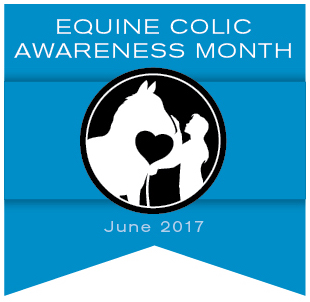Horses seem strong and majestic on the outside, but inside they have very delicate digestive systems. Many horses are at risk for mild to potentially life-threatening gastrointestinal problems, most seriously colic. Treatments and prognosis vary based on what is causing the colic episode.
The overall incidence of colic is in the range of 10-36% per year according to the Handbook of Equine Colic. More than 80% are mild episodes where a specific diagnosis is not made – known as idiopathic colic. They break down the types and frequency of colic horses experience as:
Idiopathic Colic (unknown causes)
- Mild idiopathic colic – 83%
- Impaction – 7%
- Gas colic – 4%
Non-idiopathic Colic (known causes)
- Gastric rupture – 2%
- Enteritis – 1%
- Strangulation/Torsion – 3%
- Enteroliths
- Sand
Idiopathic Colic
Idiopathic colic refers to those equine colic episodes in which there is no obvious diagnosis. The horse is showing the clinical signs of colic, but we don’t know what exactly is wrong or why. Often, these types of colic are resolved relatively easily. However, it is possible if left untreated that they will develop into a life-threatening impaction or torsion. And because we don’t know what caused it, it is likely to happen again.
This vast majority of equine colic falls into this category of the “unknown”, which ought to be a scary thing for equestrians. However, significant research over the last few years shows that most of ideopathic colics are induced as a result of feeding and care practices, and as a result can be avoided with proper management.
Impaction Colic
Another cause of equine colic is an impaction. An accumulation of sand, dirt, feed, or other indigestible material obstructs the horse’s colon, making it difficult or impossible for the horse to dispose of waste properly.
Diet management is crucial in the prevention of impaction colic, as it is a direct result of what a horse eats. Poor quality feed and lack of water cause build up that a horse cannot pass on its own. Additionally, certain feeding practices can reduce hindgut function and induce colic.
Gas Colic
Another common form of colic is gas colic, also referred to as spasmodic colic. This form of colic occurs when excess gases or fluids build up and create pressure within the digestive tract of a horse. The colon may also involuntarily contract or spasm, causing discomfort.
Most often caused by over-fermentation of food in the large intestine or inflammation along the gastrointestinal line, gas colic can also be the result of improper parasite management, colonic or gastric ulcers, and stress. While horses suffering from gas colic generally have a high rate of survival, colic can quickly escalate. Serious complications can arise if not treated promptly.
Non-Idiopathic Colic
Colics in which the cause is known are few and far between. Here are the types of colic that can be diagnosed with more certainty:
Gastric Rupture
Gastric rupture, or a rupture of the stomach is relatively rare. It is typically caused when there is an impaction in the stomach from feed materials or the stomach dilates as a result of gas build-up in the intestines. This type of gas build-up is usually a result of an obstruction somewhere in the intestines.
Enteritis
Enteritis is simply the inflammation of the intestine. The inflammation can be caused by many things, including infection, bacteria, and viruses.
Strangulation/Torsion and Intussesception
The two most lethal causes behind colic in horses are strangulation/torsion (a twist in the gastrointestinal system of a horse) and intussusception (when the intestine slides back into itself, causing blockage). In both cases the blood supply may be partially or more likely, completely cut off, resulting in dead tissue, and the passage of food can be blocked.
Our research has shown that horses with hindgut acidosis tend to have flaccid colons, which are more susceptible to twists. Gas can also cause portions of the GI tract to rise and fold in on itself, and on some occasions a more mild form of colic can turn into a torsion due to a horse rolling or thrashing in an attempt to relieve pain.
Tapeworms and other parasites are the main culprits behind intussusception. Regular deworming can help reduce the risk to your horse. If emergency care is not rendered immediately, torsions and intussusception can cause death in under 12 hours; even with proper treatment, some cases are fatal. These worst-case scenarios are the reason every instance of colic should be treated with urgency.
Enteroliths
An enterolith is a specific type of impaction colic caused by naturally-occuring mineral deposits. Enteroliths are stone-like formations of minerals that form around a foreign object a horse eats but can’t digest. These stones can grow as large as 10-15 pounds. The stones form in the large colon and can migrate to smaller areas where they cause problems including colic. Enteroliths seldom completely block the passage of feed through the digestive tract.
Sand Colic
Sand colic is a type of impaction that occurs when a horse grazes on grass in dusty soil, often collecting upwards of 30-80 pounds of sand and dirt in its gastrointestinal tract before colicking. Horses in sandy regions are highly susceptible and often require additional preventative measures including supplements and feeding methods that keep hay and grain off the ground.
If your horse does show signs of colic, remove feed, keep it from exerting itself, and contact your veterinarian immediately. While not every instance of colic is lethal, any minor problem can rapidly turn into a major emergency. Learn more about treatment options for colic.
The very best cure for equine colic is prevention. Learn more about what you can do to help your horse avoid induced colic.






